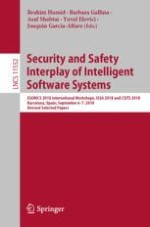This book constitutes the thoroughly refereed post-conference proceedings of the International Workshop on Interplay of Security, Safety and System/Software Architecture, CSITS 2018, and the International Workshop on Cyber Security for Intelligent Transportation Systems, ISSA 2018, held in Barcelona, Spain, in September 2018, in conjunction with the 23rd European Symposium on Research in Computer Security, ESORICS 2018.
The ISSA 2018 workshop received 10 submissions from which 3 full papers and 1 short paper were accepted. They cover topics such as software security engineering, domain-specific security and privacy architectures, and automative security. In addition, an invited paper on safety and security co-engineering intertwining is included. The CSITS 2018 workshop received 9 submissions from which 5 full papers and 1 short paper were accepted. The selected papers deal with car security and aviation security.
